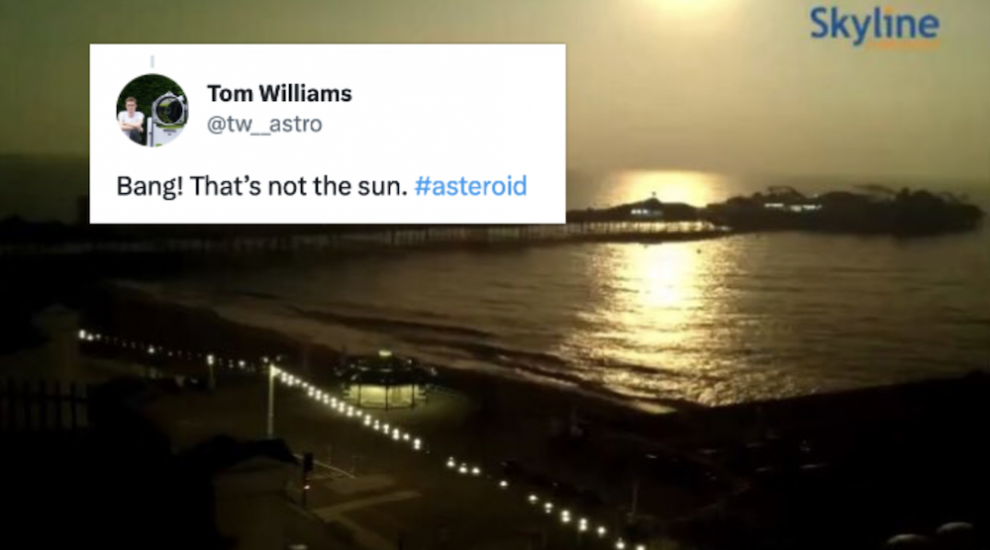


A small asteroid heading for the Normandy region was seen by stargazers in St Martins in the early hours of this morning - with detection equipment across Europe accurately predicting its movements and the time of impact.
Twitter user Tom Williams (@tw__astro), who is based in Wiltshire, England, describes himself as a 20 year old amateur astrophotographer.
Last night he warned that "a small asteroid" around one metre in size around, was expected to "safely impact the French-English channel".
He predicted it would make impact at around 03:00 and would "appear as bright as the moon momentarily as it enters the atmosphere".
It did just that, as captured in these videos taken by Will Dereham at Jerbourg and Ramsay Elson.
Mr Williams adjusted his prediction as the impact time neared and was able to accurately track the asteroid over a period of five hours.
He credited fellow star gazers with helping him including the staff of the Konkoly Observatory in Hungary who initially spotted and tracked the asteroid, and his friend "respectable comet/asteroid enthusiast, friend and planetary scientist, Sam Deen".
pic.twitter.com/Ckh5OBsz4l
— Tom Williams (@tw__astro) February 12, 2023
Above: Mr Williams Twitter thread on the asteroid can be seen by clicking on the link above.
Mr Williams told Express: "I first was made aware of its existence around five hours before atmospheric entry - by a friend who closely monitors these things (Sam Deen, planetary scientist).
"We both knew this was the 7th pre-impact detection, and one with enough time to enable meaningful observation. I only mentioned sharing this information on Twitter in passing, but we quickly decided that it might enable a few lucky people to get a once in a lifetime view.
"Since then, I’ve had 100s of people state I (and Sam Deen) were what made their experiences possible. Mission accomplished."
Mr Williams described the asteroid as a "rare event" and he said he hoped his work in documenting its arrival was "rewarding" for those reading.
"I think it’s great to spread such info around and get more people exited in space - these transient events can’t be missed! Especially when they appear so well-placed in a populated area."
#SAR2776 30 seconds ago pic.twitter.com/6IYwPPazph
— Andy Cooper (@scute1133) February 13, 2023
Replying to one follower on his thread, Mr Williams confirmed: "It's only the 7th such object in history to be detected prior to impact, as I understand", underlining how rare an event it was.
The asteroid was sighted across the south coast of England as well as the French coast. Videos and pictures posted on Twitter depict the asteroid shining brightly as it made impact with people saying it appeared bright orange, or green depending on where they were.
Those tracking the asteroid were able to pinpoint its arrival time to 02:59:16.8. After it had landed it was classified as 2023 CX1.
Within hours of the asteroid having made impact it already had its own Wikipedia page which detailed that 2023 CX1, previously known as SAR2667, had been discovered by Hungarian Astronomer Krisztián Sárneczky who is based at the Konkoly Observatory which Mr Williams credited in his Twitter thread above.
It was tracked for seven hours before its impact - initially described as "a near-Earth asteroid on an Earth-crossing Apollo-type orbit".
thank you so much for your thread. unforgettable moment
— (@aes_2fish) February 13, 2023
lit up the sky and disintegrated in a bright shade of green before dipping under the treeline
i could see it breaking up as it dove. Pic taken from ~200km away pic.twitter.com/r3ZKWNcRsj
Using Mr Sárneczky's initial observations others were able to track the asteroid as it moved an an angular rate of 14 arc seconds per minute with an accelerating radial velocity of 9 km/s with an initial apparent magnitude of 19.4.
Mr Sárneczky gave it the temporary designation SAR2667 and reported it to the Minor Planet Centre's Near Earth Object Confirmation Page which alerted other observatories to enable clarification from multiple sources.
The Višnjan Observatory at Tičan, Croatia was next to officially observe the asteroid, confirming at 21:03 UTC that it was heading for the Earth.
It was at this time that Mr Williams started tracking it online with the initial impact time of 03:00 being adjust by milliseconds to give an accurate landing time.
20 observatories are now known to have observed and submitted astrometry of the meteoroid before its impact.
Saw this through my window after been woken up by the sound of my son going out the front door to watch it. It was very bright! https://t.co/FaG0lyoy3T
— Yvonne Burford (@YvonneBurford) February 13, 2023
Deputy Yvonne Burford and her son both saw it from their home in Guernsey.
La Société Guernesiaise said this morning that volunteers would be checking the All Sky camera at the island's observatory later today which may have captured images of the rare event.
Comments
Comments on this story express the views of the commentator only, not Bailiwick Publishing. We are unable to guarantee the accuracy of any of those comments.